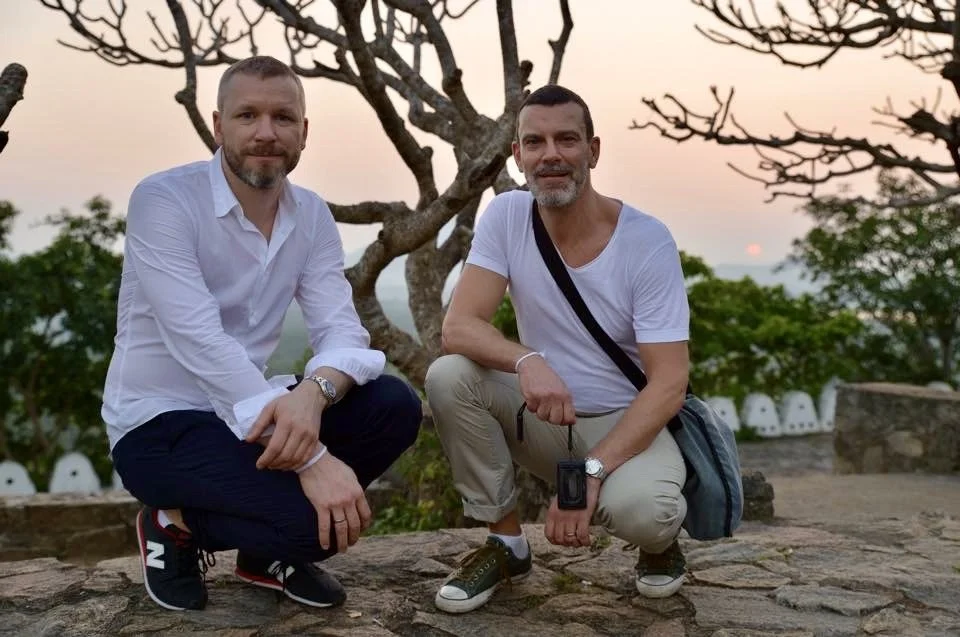Perched on a quiet hillside above the golden shores of Zipolite, El Guayacán offers something rare: stillness with soul, privacy with personality, and a kind of design that feels not only beautiful but deeply respectful of its surroundings. From its thoughtful construction to its heartfelt hospitality, this adults-only retreat invites travelers to experience a slower, more intentional way of staying.
For Martti Wichmann and Fridtjof Flucke, owners and managers of El Guayacán, the journey began with a sense of connection.
“The luxury of doing nothing, enjoying naked sunbathing, and the acceptance for all creatures that blossomed out of humanity make this place unique—but maybe not for everyone.”
– Martti Wichmann & Fridtjof Flucke, Owners and Managers
While the town is known for being home to Mexico’s only legal nude beach, its charm lies in something deeper. There are no high-rises or nightclubs here, no all-inclusive resorts or loud distractions. Instead, you will find unpaved streets, open-minded locals, cozy beach bars, and a slow rhythm that welcomes everyone just as they are.
A Vision Built with Care
Martti and Fridtjof came to Zipolite after years of traveling for both work and pleasure. With backgrounds in sales, marketing, hospitality, and retail, they knew what good service looked like—and what was missing.
“We discovered the need for high-quality accommodation with professional hospitality,” they share. “When we arrived for the first time in 2017, we immediately fell in love with this place. We returned many times and finally decided to settle, live, and offer hospitality.”
They searched for the right location for a long time before discovering a quiet piece of land surrounded by a creek, elevated 46 meters above sea level. The views stretched to the Pacific Ocean in one direction and to the mountains of the Sierra Madre del Sur in the other. The site offered privacy, beauty, and a perfect canvas for their vision.
After a year and a half of planning and three years of construction, El Guayacán opened in February 2025. Local architecture firm Permacasco led the build, guided by a deep understanding of the region’s climate and materials. The interiors were designed in collaboration with hospitality expert Juan-Carlos Rodriguez Artigas, while the artwork was curated by French gallerist and textile designer Thomas Flechel, who splits his time between Mexico City and Zipolite.
“We followed the principle of indoor and outdoor living merging perfectly in every space.”
– Martti Wichmann & Fridtjof Flucke, Owners and Managers
The result is a serene and seamless design that incorporates local wood, stone, concrete, and whitewashed walls. The property includes two double rooms with private terraces, three Casitas with fully equipped kitchens and outdoor bathrooms, and Casa Cuixe, a standalone two-bedroom beach house with panoramic views. At the center is a 17-meter lap pool overlooking both the ocean and the village below.
A Deep Commitment to Sustainability
At El Guayacán, sustainability is not a feature—it is the foundation.
“From the very beginning, we’ve built with intention to honor the land, the community, and the future,” Martti and Fridtjof explain. “Sustainability is the heart of our action.”
The property is powered by solar energy and collects rainwater from every roof. Water is stored in an onsite cistern and reused throughout the hotel thanks to a custom treatment system. This approach reduces pressure on local groundwater supplies, which are vital to the community.
“It’s a deliberate and respectful choice that protects shared resources and supports the long-term well-being of both our neighbors and the surrounding ecosystem.”
– Martti Wichmann & Fridtjof Flucke, Owners and Managers
Their thoughtful design ensures that each guest experience has a minimal environmental footprint while still feeling elevated and luxurious.
For the Discerning and the Curious
El Guayacán is designed for travelers who value peace, privacy, and presence. It appeals to individuals and couples seeking something quiet yet enriching, somewhere to slow down without sacrificing quality.
“We attract discerning local and international guests looking for authentic, quality accommodation in a respectful and peaceful environment,” Martti and Fridtjof note. “And we’re just a few minutes’ walk from the center of the village, the beach, and the restaurants.”
Guests are encouraged to explore the community around them. Local favorites include Órale Café, a relaxed breakfast spot just steps away, and Casa Mexoni, where guests can shop for handmade textiles, jewelry, and mezcal. Yemaya is a nearby beachfront restaurant known for its modern twist on Mexican cuisine. And for a more scenic outing, Playa del Amor and Punta Cometa offer stunning ocean views and unforgettable sunsets.
A Global Perspective, A Local Soul
El Guayacán reflects the couple’s global perspective on what hospitality can be when it is done with heart. Their favorite stays include Hotel Almhof Schneider in Austria for its timeless warmth, Brücke 49 in Switzerland for its balance of design and authenticity, and Psili Ammos in Greece, which they describe as “a proof that perfection is not in the number of stars you have but in the approach you have to hospitality.”
The same spirit lives in El Guayacán. Every detail is considered. Every space is built with meaning. And every stay offers something to take with you, whether it’s a new rhythm, a deeper connection, or simply a quiet place to rest.
This is not just a hotel. It is a place where you can feel the land, find your breath, and be fully here. And fully away.












